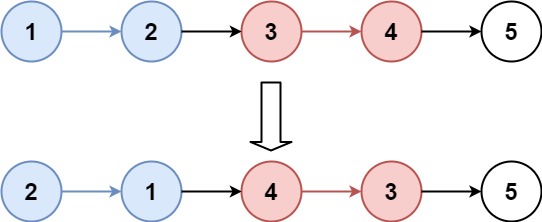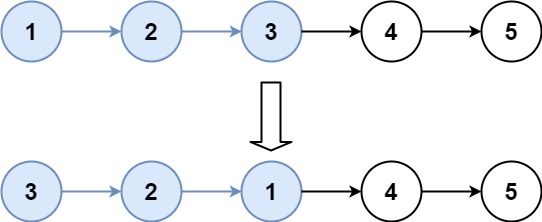LeetCode-in-Swift
25. Reverse Nodes in k-Group
Hard
Given a linked list, reverse the nodes of a linked list k at a time and return its modified list.
k is a positive integer and is less than or equal to the length of the linked list. If the number of nodes is not a multiple of k then left-out nodes, in the end, should remain as it is.
You may not alter the values in the list’s nodes, only nodes themselves may be changed.
Example 1:

Input: head = [1,2,3,4,5], k = 2
Output: [2,1,4,3,5]
Example 2:

Input: head = [1,2,3,4,5], k = 3
Output: [3,2,1,4,5]
Example 3:
Input: head = [1,2,3,4,5], k = 1
Output: [1,2,3,4,5]
Example 4:
Input: head = [1], k = 1
Output: [1]
Constraints:
- The number of nodes in the list is in the range
sz. 1 <= sz <= 50000 <= Node.val <= 10001 <= k <= sz
Follow-up: Can you solve the problem in O(1) extra memory space?
To solve the “Reverse Nodes in k-Group” problem in Swift with a Solution class, we can reverse the nodes in groups of k using a recursive approach. Here are the steps:
- Define a
Solutionclass. - Define a method named
reverseKGroupthat takes the head of a linked list and an integer k as input and returns the head of the modified list. - Define a helper method named
reversethat takes the head and tail of a sublist as input and reverses the sublist in place. This method returns the new head of the sublist. - Create a dummy ListNode object and set its
nextpointer to the head of the input list. This dummy node will serve as the new head of the modified list. - Initialize pointers
prev,curr,next, andtail. Setprevandtailto the dummy node, andcurrto the head of the input list. - Iterate through the list:
- Move
currk steps forward. If it’s not possible (i.e., there are less than k nodes left), break the loop. - Set
nextto thenextpointer ofcurr. - Reverse the sublist from
currtonextusing thereversemethod. Updateprevandtailaccordingly. - Move
prevandtailk steps forward to the last node of the reversed sublist. - Move
currtonext.
- Move
- Return the
nextpointer of the dummy node, which points to the head of the modified list.
Here’s the implementation:
/**
* Definition for singly-linked list.
* public class ListNode {
* public var val: Int
* public var next: ListNode?
* public init() { self.val = 0; self.next = nil; }
* public init(_ val: Int) { self.val = val; self.next = nil; }
* public init(_ val: Int, _ next: ListNode?) { self.val = val; self.next = next; }
* }
*/
public class Solution {
public func reverseKGroup(_ head: ListNode?, _ k: Int) -> ListNode? {
if head == nil || head?.next == nil || k == 1 {
return head
}
var len = head
var j = 0
while j < k {
if len == nil {
return head
}
len = len?.next
j += 1
}
var c = head
var n: ListNode? = nil
var prev: ListNode? = nil
var i = 0
while i < k {
n = c?.next
c?.next = prev
prev = c
c = n
i += 1
}
head?.next = reverseKGroup(c, k)
return prev
}
}
This implementation provides a solution to the “Reverse Nodes in k-Group” problem in Swift without modifying the values in the list’s nodes. It recursively reverses the nodes in groups of k.

